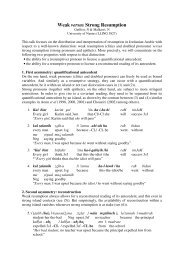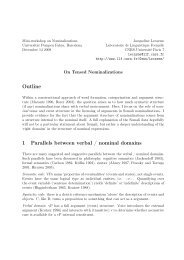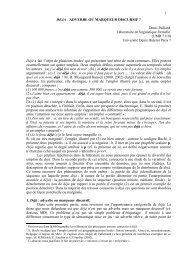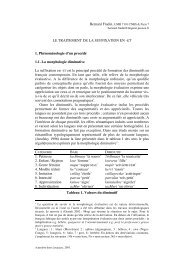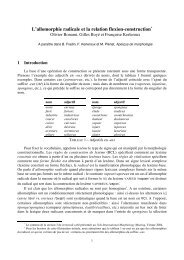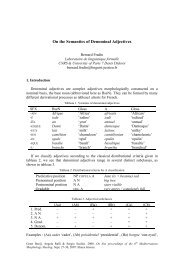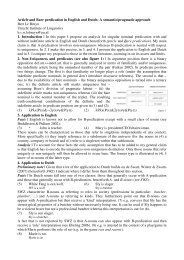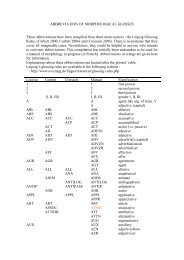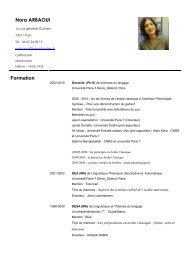An Introductory Note to Noam Agmon's “Materials and ... - CNRS
An Introductory Note to Noam Agmon's “Materials and ... - CNRS
An Introductory Note to Noam Agmon's “Materials and ... - CNRS
Create successful ePaper yourself
Turn your PDF publications into a flip-book with our unique Google optimized e-Paper software.
Brill’s <strong>An</strong>nual of Afroasiatic Languages <strong>and</strong> Linguistics 2 (2010) 1–22 brill.nl/baall<br />
<strong>An</strong> <strong>Introduc<strong>to</strong>ry</strong> <strong>Note</strong> <strong>to</strong> <strong>Noam</strong> Agmon’s<br />
<strong>“Materials</strong> <strong>and</strong> Language” with Special Attention<br />
<strong>to</strong> the Issue of Biliteral Roots *<br />
Jean Lowenstamm<br />
Université Paris-Diderot, <strong>CNRS</strong><br />
jean.lowenstamm@linguist.jussieu.fr<br />
Abstract<br />
Biliteral roots have been, <strong>and</strong> still are controversial. Because <strong>Noam</strong> Agmon’s paper, <strong>to</strong> which<br />
this note is an introduction, assumes the reality of biliteral roots, the issue is revisited. Several<br />
important arguments in support of the biliterality of C1C2C2 <strong>and</strong> C1C1C2 verbs were put forth<br />
in the course of the past thirty years. They are reviewed here, along with the criticisms they have<br />
triggered. It is concluded that the evidence weighs in favor of recognizing synchronically active<br />
biliteral roots subjected <strong>to</strong> templatic pressure. It is further suggested that a by-product of Agmon’s<br />
study <strong>and</strong> findings is a time frame for the emergence of templatic morphology in the Middle East.<br />
Keywords<br />
biliteral <strong>and</strong> triliteral roots; deaf verbs; templates; OCP; Arabic; Aramaic; Ethiopic; Chaha<br />
Pour Monette Beserman<br />
0. Preamble<br />
BAALL is primarily committed <strong>to</strong> the publication of theoretical <strong>and</strong> descriptive<br />
articles on the phonology, morphology, syntax, semantics <strong>and</strong> diachrony of<br />
Afroasiatic languages, including work of a comparative nature possibly involving<br />
non-Afroasiatic as well as Afroasiatic data. Nevertheless, at the invitation<br />
of one of the edi<strong>to</strong>rs, BAALL may occasionally publish research conducted at<br />
the periphery of these subfields, along with an edi<strong>to</strong>rial comment aimed at<br />
providing perspective <strong>and</strong> highlighting the theoretical significance of the contribution.<br />
Our first such article is <strong>Noam</strong> Agmon’s <strong>“Materials</strong> <strong>and</strong> Language:<br />
Pre-Semitic Structural Change Concomitant with Transition <strong>to</strong> Agriculture”.<br />
Agmon is a theoretical physical chemist at the Hebrew University in Jerusalem.<br />
*) I am grateful <strong>to</strong> <strong>Noam</strong> Agmon, Sabrina Bendjaballah, Yigal Bloch, <strong>Noam</strong> Faust, Brenda Laca,<br />
<strong>and</strong> Jamal Ouhalla for comments on this paper. Of course, I take full responsibility for positions<br />
expressed therein.<br />
© Koninklijke Brill NV, Leiden, 2010 DOI: 10.1163/187666310X12688137960902
2<br />
Jean Lowenstamm / Brill’s <strong>An</strong>nual of Afroasiatic Languages <strong>and</strong><br />
Linguistics 2 (2010) 1–22<br />
The research on which he reports in his paper was presented <strong>and</strong> discussed in<br />
several places, including an interdisciplinary group involving two archeologists,<br />
a philologist, <strong>and</strong> a computer scientist. It has also benefitted from the input of<br />
a geologist <strong>and</strong> a linguist. The copious etymological appendix at the end of<br />
the paper is due <strong>to</strong> Yigal Bloch, a doc<strong>to</strong>ral c<strong>and</strong>idate in Jewish Studies at the<br />
Hebrew University in Jerusalem.<br />
1. Introduction<br />
Pro<strong>to</strong>-Semitic takes us approximately 6000 years back, that is some 4000 years<br />
after the completion of the agricultural revolution in Western Asia. Is it possible<br />
<strong>to</strong> go back further beyond those 6000 years without having <strong>to</strong> tap the<br />
much more speculative results of the reconstruction of pro<strong>to</strong>-Afroasiatic? It is<br />
Agmon’s claim that consideration of astutely selected external evidence makes<br />
it possible <strong>to</strong> discern distinct layers in the pro<strong>to</strong>-Semitic lexicon. Specifically,<br />
archeological evidence interpreted in the light of what is known of early technology<br />
yields the striking generalizations in (1).<br />
(1) i. the names of materials <strong>and</strong> technological processes which could not<br />
possibly have been available before the agricultural revolution all involve<br />
triconsonantal roots<br />
ii. biconsonantal roots exclusively underlie the names of materials <strong>and</strong><br />
technological processes which had <strong>to</strong> be available before the agricultural<br />
revolution<br />
Of course, Agmon’s thesis presupposes that there is such a thing as a biconsonantal<br />
root. As such, it naturally links up with, <strong>and</strong> possibly sheds light on,<br />
a great classic of Semitic linguistics, viz. does the currently prevailing triconsonantal<br />
root format stem entirely or partially from an earlier biconsonantal<br />
structure? The spectrum of emotions, attitudes, opinions, <strong>and</strong> postures that<br />
have been triggered by this query for over a millenium is unparalleled, ranging<br />
from sheer passion <strong>to</strong> cold dismissal of the issue itself. 1 For general discussion,<br />
cf. Goldenberg (2005), Voigt (1988), Zaborski (1991) <strong>and</strong> references<br />
therein.<br />
This writer is entirely dispassionate with respect <strong>to</strong> the answer, or even the value<br />
of raising the question itself. Indeed, whether it can be established that Semitic<br />
1) See for instance the summary dismissal of Mayer Lambert (1897)’s early theory of etymons<br />
by Kautzsch, the edi<strong>to</strong>r of various versions of Gesenius’s Hebrew Grammar (Gesenius himself<br />
died in 1842), starting with the 27th edition (1902) <strong>and</strong> reproduced thereafter in all subsequent<br />
editions.
Jean Lowenstamm / Brill’s <strong>An</strong>nual of Afroasiatic Languages <strong>and</strong><br />
Linguistics 2 (2010) 1–22 3<br />
roots were originally biconsonantal, or alternatively triconsonantal, or whether<br />
both types have <strong>to</strong> be recognized, is an empirical issue. If it can be settled (one<br />
way or the other), a fact will have been brought <strong>to</strong> light. The importance of<br />
such a fact is exactly defined by a) the status of the question <strong>to</strong> which that fact is<br />
a possible answer, b) the theoretical framework from which the question itself<br />
derives. 2<br />
In this brief note, I intend <strong>to</strong> offer a personal assessment of the importance<br />
of Agmon’s findings, one which may or may not exactly correspond <strong>to</strong> his<br />
own. I will proceed in roundabout fashion. First, in the next section (2.),<br />
I rapidly sketch out some of the arguments which have led <strong>to</strong> the idea that<br />
(some) Semitic roots might have originated as biconsonantal. In the following<br />
section (3.), I will revisit what I see as a highly significant trilogy of papers<br />
directly bearing on the issue, viz. a) McCarthy’s treatment of Arabic deaf verbs<br />
(McCarthy 1981), b) Chaha morphology (McCarthy 1983), <strong>and</strong> c) a brief but<br />
important note on Aramaic due <strong>to</strong> Georges Bohas (Bohas 1990). In a fourth<br />
section, I discuss <strong>and</strong> evaluate some of the objections that have been raised<br />
in connection with McCarthy’s proposals. Specifically, I argue on the basis of<br />
Chaha C1C2C2 <strong>and</strong> C1C1C2 verbs that the existence of the latter class does not<br />
invalidate McCarthy’s analysis of Arabic deaf verbs. Finally, in the fifth <strong>and</strong><br />
concluding section, I return <strong>to</strong> Agmon’s paper proper. There, I suggest that<br />
Agmon may have dated the emergence of templatic morphology in Western<br />
Asia.<br />
2. How did the issue of biradicality arise in the first place?<br />
Two main considerations are involved. The first consideration has <strong>to</strong> do with<br />
the intriguing properties of Semitic roots in (2).<br />
(2) i. systematic root triliterality is rare in the language families of the world,<br />
even in the Afroasiatic family<br />
ii. strictly consonantal roots are rare <strong>to</strong>o, both outside <strong>and</strong> inside the<br />
Afroasiatic family<br />
A second consideration can be illustrated by means of the hypothetical array<br />
of roots in (3). 3<br />
2) Sheer curiosity is also a possible source of questions, though in that case their relevance remains<br />
unspecified.<br />
3) <strong>An</strong>y resemblance between the hypothetical roots in (3) <strong>and</strong> actual Semitic roots should be<br />
viewed as irrelevant.
4<br />
(3) a. √ tff f. √ tfq<br />
b. √ ytf g. √ rzq<br />
c. √ tfy h. √ wdq<br />
d. √ ntf i. √ btq<br />
e. √ dtf j. √ sgq<br />
Suppose the following:<br />
Jean Lowenstamm / Brill’s <strong>An</strong>nual of Afroasiatic Languages <strong>and</strong><br />
Linguistics 2 (2010) 1–22<br />
(4) i. all the roots in the leftmost column in (3) share a core meaning, say<br />
‘move’<br />
ii. the initial n in (3d) can plausibly be analyzed as an affix, say an inchoative<br />
iii. the d in (3e) cannot be identified as a specific affix, but the fact that it<br />
violates a prohibition against homorganicity between adjacent consonants,<br />
singles it out as a likely augment of some sort 4<br />
iv. all the roots in the rightmost column are realized as say, telic verbs;<br />
accordingly, the fact that they all share a final q suggests that q signals<br />
telicity; hence q is an augment, <strong>to</strong>o 5<br />
The conclusion is inescapable: √ tf can be isolated as an ingredient, possibly a<br />
root. But suppose further (5).<br />
(5) i. no known Semitic language displays a CVC noun, verb or adjective<br />
whose paradigm of realization exclusively includes tĭf, ortăf, ortŭf<br />
(crucially, not tĭff,ortăff,ortŭff )<br />
ii. no known single Semitic language displays the entirety of the array in<br />
(3); rather several, say 6, different Semitic languages were required for<br />
thesamplein(3)<strong>to</strong>beput<strong>to</strong>gether<br />
A qualification now appears <strong>to</strong> be required: if √ tf is an ingredient (possibly a<br />
root), it can only pertain <strong>to</strong> an older, more ancient, reconstructed, layer. Thus,<br />
for Ewald (1870), √ tf would be a pro<strong>to</strong>-root (Urwurzel), while a corresponding,<br />
synchronically active, “truly alive” root (‘wirklich lebende Wurzel’) could<br />
only be triliteral, viz. √ tff (cf. Goldenberg 2005 for a contemporary endorsement<br />
of Ewald’s position). But, if √ tf is never a synchronically active root, is<br />
it more than just a linguistic fiction? One generation earlier, Gesenius (1834)<br />
had expressed similar misgivings, though in more tentative <strong>to</strong>ne, noting that<br />
‘monosyllabic (= biconsonantal) Hebrew roots are like the hidden root of a<br />
4) <strong>An</strong> argument of just that type is put forth in Kuryłowicz (1972).<br />
5) Arguments of that nature are developed in Bohas (1997, 2000) <strong>and</strong> Ehret (1989), though <strong>to</strong><br />
different ends.
Jean Lowenstamm / Brill’s <strong>An</strong>nual of Afroasiatic Languages <strong>and</strong><br />
Linguistics 2 (2010) 1–22 5<br />
tree, of which only the trunk, the branches <strong>and</strong> the buds are visible’. 6 He went<br />
on <strong>to</strong> say that the roots of words are pro<strong>to</strong>-ingredients, ‘often unknown <strong>and</strong><br />
problematic inasmuch as they do not occur as such, <strong>and</strong> can only be accessed<br />
by means of combina<strong>to</strong>ry procedures’, presumably of the kind sketched out<br />
in (4) above. Without making <strong>to</strong>o much of it, <strong>and</strong> with all due respect, it is<br />
tempting <strong>to</strong> object that Gesenius’s botanical metaphor cuts both ways: invisible<br />
as it may be, the root of a tree is itself as alive as the trunk, the branches<br />
or the buds. In fact, there could be no tree without a root. In the next section,<br />
I examine a compelling bundle of arguments leading <strong>to</strong> a forceful rejection of<br />
the idea that the biradical root belongs in the world of fossiles. On the contrary,<br />
it appears <strong>to</strong> be thriving in rich <strong>and</strong> fragrant synchronic soil. 7 The following<br />
remarks are confined <strong>to</strong> two types of verbal formations, the deaf kind, C1C2C2,<br />
<strong>and</strong> the stutterers, C1C1C2.<br />
3. Three important papers<br />
A major conceptual breakthrough in the approach <strong>to</strong> the structure of Semitic<br />
roots is due <strong>to</strong> John McCarthy. In two important papers, (McCarthy 1981,<br />
1983), McCarthy put forth arguments which have become impossible <strong>to</strong><br />
ignore both by those who oppose the idea that some roots are biradical, e.g.<br />
Goldenberg (2005), <strong>and</strong> by those who question the very relevance of the root<br />
(cf. Faust & Hever (this volume) for discussion of such positions). A third<br />
important paper (Bohas 1990) completes the demonstration.<br />
3.1. Classical Arabic deaf verbs<br />
In his treatment of Classical Arabic verbal morphology, McCarthy (1981)<br />
proposes that consonantal roots link up <strong>to</strong> templatic positions as shown in (6),<br />
where the template directly represents the prosody of the derivational class in<br />
which the verb is realized. The examples in (6) describe the realization of roots<br />
√ ktb <strong>and</strong> √ -hmr in Forms I <strong>and</strong> IX, respectively (cf. e.g. katab-tu ‘I wrote’,<br />
(?i) - hmarar-na ‘we reddened’). 8 The mode of association is one-<strong>to</strong>-one <strong>and</strong> left<strong>to</strong>-right,<br />
as per the classic conventions of au<strong>to</strong>segmental phonology (Goldsmith<br />
1976), reflected here in the numbering of arrows.<br />
6) Whereas Gesenius published his first grammar in 1813, he does not discuss the root until the<br />
11th edition (Gesenius 1834).<br />
7) Cf. also Nöldeke (1910).<br />
8) For the sake of clarity, the vocalic melody, as well as inflectional <strong>and</strong> prothetic material, has<br />
been left out of the description in (6).
6<br />
(6)<br />
Jean Lowenstamm / Brill’s <strong>An</strong>nual of Afroasiatic Languages <strong>and</strong><br />
Linguistics 2 (2010) 1–22<br />
In (6a), the number of consonantal positions in the template is the same as<br />
the number of root consonants, <strong>and</strong> the effect of left-<strong>to</strong>-right association is<br />
not discernible. On the other h<strong>and</strong>, in (6b), the rightmost root consonant is<br />
seen <strong>to</strong> spread rightward, so as <strong>to</strong> allow for a full phonetic interpretation of all<br />
four templatic consonantal positions. In this case, the effect of directionality is<br />
clear.<br />
McCarthy points out that if root consonants are mapped on<strong>to</strong> templates as<br />
sketched out above, a puzzle going back a millenium or more, is immediately<br />
solved. It had been noted, but left unexplained, that Classical Arabic <strong>and</strong><br />
Biblical Hebrew display verbs with identical second <strong>and</strong> third consonants, such<br />
as Arabic madadna ‘we extended’ or Biblical Hebrew sōe ‘it goes round’,<br />
but no or very few verbs with identical first <strong>and</strong> second consonants such as<br />
*mamadna or *sōse. 9,10 Under McCarthy’s scheme, madad is derived as shown<br />
in (7a).<br />
(7)<br />
madad, if viewed as crucially stemming from biradical root √ md, results from<br />
(7a), but putative mamad (7b) is ruled out because move 2 in (7b) involves a<br />
violation of one-<strong>to</strong>-one association cum eventual spreading. However, ungrammatical<br />
mamad is not yet rendered impossible al<strong>to</strong>gether. Indeed, if the root<br />
underlying madad is represented as triliteral, grammatical madad would<br />
9) Cf. Greenberg (1950) for discussion.<br />
10) In reality, there is a h<strong>and</strong>ful of such verbs in Biblical <strong>and</strong> in Modern Hebrew. Those colleagues<br />
who feel that they do form a pattern (as opposed <strong>to</strong> a collection of hapactic formations) must put<br />
forth some justification for why that putative pattern should be so scarcely exemplified.
Jean Lowenstamm / Brill’s <strong>An</strong>nual of Afroasiatic Languages <strong>and</strong><br />
Linguistics 2 (2010) 1–22 7<br />
certainly result (8a). But then, nothing would rule out the existence of a root<br />
such as √ mmd, yielding *mamad (8b) without involving any violation of the<br />
association conventions.<br />
(8)<br />
Clearly, the triliteral analysis is <strong>to</strong>o permissive: unlike the biliteral analysis in<br />
(7), it fails <strong>to</strong> rule out the unattested verbs. Indeed, it begs the question of<br />
their inexistence in Arabic. In order <strong>to</strong> rule out the analyses in (8), McCarthy<br />
invokes the Obliga<strong>to</strong>ry Con<strong>to</strong>ur Principle (henceforth OCP) of which a versionappearsin(9).<br />
11<br />
(9) The adjacency of two identical objects results in ungrammaticality<br />
The OCP will readily rule out both configurations in (8) on account of the<br />
adjacency of identical objects at the root level, d <strong>and</strong> d in (8a) <strong>and</strong> m <strong>and</strong> m in<br />
(8b). No such objection weighs against the biliteral analyses in (7), although<br />
(7b) is of course excluded on account of the violation of the association<br />
conventions pointed out above. As we see, given McCarthy’s framework, the<br />
Classical Arabic state of affairs falls out as a theorem. The results of McCarthy’s<br />
proposal with respect <strong>to</strong> Arabic deaf verbs can be summed up as in (10).<br />
(10) i. C1C1C2 verbs do not exist in Arabic because there is no possible source<br />
for them<br />
ii. C1C2C2 verbs can only proceed from a biliteral root<br />
Beyond the striking formal elegance of an account directly addressing <strong>and</strong><br />
answering a question which had baffled Semiticists since the Middle Ages,<br />
(10ii) is of special interest in the context of this note: the biradicality of deaf<br />
verbs can no longer be viewed as resulting from the freewheeling creativity<br />
11) It is worth noting that the OCP was not devised <strong>to</strong> h<strong>and</strong>le Semitic morphology or even<br />
the structure of consonant clusters in the languages of the world. Rather, its initial motivation<br />
is rooted in the analysis of <strong>to</strong>ne systems (cf. Leben 1977). As such, the OCP is independantly<br />
motivated, <strong>and</strong> its mobilization adds nothing <strong>to</strong> the cost of McCarthy’s explana<strong>to</strong>ry scheme. For<br />
a detailed discussion of the OCP in connection with the structure of Tigrinya roots, cf. Buckley<br />
(1997a).
8<br />
Jean Lowenstamm / Brill’s <strong>An</strong>nual of Afroasiatic Languages <strong>and</strong><br />
Linguistics 2 (2010) 1–22<br />
of unrealistic reconstructionists; 12 rather, it is as synchronically real <strong>to</strong>day as<br />
it must have been at every earlier stage, going as far back as pro<strong>to</strong>-Semitic.<br />
As it turns out, further evidence comes forth in support of the biradical<br />
analysis.<br />
3.2. Chaha 2nd person singular feminines<br />
In McCarthy (1983), several processes of Chaha are reviewed <strong>and</strong> shown <strong>to</strong><br />
provide very strong evidence for one-<strong>to</strong>-many associations of root consonants<br />
<strong>to</strong> templatic positions. 2nd Person Singular Feminine Palatalization will be<br />
discussed here. Impersonal formation will be briefly discussed in 4. below. 13<br />
In Chaha, the 2nd Person Singular Feminine minimally differs in the following<br />
way from its corresponding Masculine in the Imperfective <strong>and</strong> Jussive<br />
paradigms: the 2nd Person Singular Feminine is realized by means of a floating<br />
palatalizing prosody affecting the rightmost palatalizable root consonant, a<br />
velar or an oral coronal obstruent. 14 Examples appear in (11), each paired with<br />
its corresponding Masculine for control. In (11a), the last root consonant is<br />
palatalizable. 15 Not so in (11b). In consequence, the Feminine exponent has<br />
<strong>to</strong> look further inside the root <strong>and</strong> eventually docks on<strong>to</strong> C2.<br />
(11) Imperfective Jussive<br />
2nd ms. 2nd fem. 2nd ms. 2nd fem.<br />
a. √ dmd ‘put <strong>to</strong>gether’ tıdämıd 16 tıdämıd y dımd dımd y<br />
b. √ rgf ‘fall (leaves)’ tırägıf tıräg y ıf nıgıf nıg y ıf<br />
If both the last <strong>and</strong> the penultimate root consonants are palatalizable, the last<br />
one only, crucially not both, will be affected, as shown in (12).<br />
12) See also Zygmunt Frajzyngier’s valuable contemporary paper (Frajzyngier 1979) which deals<br />
with very similar concerns.<br />
13) Cf. Leslau (1950, 1997) for a description of the Impersonal.<br />
14) Reconciling the floating behavior of the 2nd Feminine Singular exponent with its unquestionable<br />
suffixal identity, is a representational challenge. Cf. Lowenstamm (2000) for a proposal.<br />
15) All palatalized coronals are realized as pala<strong>to</strong>alveolar stridents. For the sake of clarity, I follow<br />
McCarthy (1983), in representing all palatalized consonants, coronals as well as velars, with a<br />
superscript y, viz. C y .<br />
16) [ä] <strong>and</strong> [ı] are central vowels, low <strong>and</strong> high, respectively. For an account of the proliferation of<br />
central vowels in Ethiopian Semitic, cf. Lowenstamm (1991). For a rejoinder based on Tigrinya<br />
evidence, cf. Buckley (1997b). [ı] is extremely unstable <strong>and</strong> drops out from the phonetic signal<br />
at the first opportunity. The effects of the syncope leading <strong>to</strong> its absence are not recorded in this<br />
paper.
Jean Lowenstamm / Brill’s <strong>An</strong>nual of Afroasiatic Languages <strong>and</strong><br />
Linguistics 2 (2010) 1–22 9<br />
(12) Imperfective Jussive<br />
2nd ms. 2nd fem. 2nd ms. 2nd fem.<br />
√<br />
dgs ‘entertain’ tıdägıs y tıdägıs dıgıs dıgısy *tıdäg y ıs y *dıg y ıs y<br />
Now, deaf verbs such as sädädä ‘he drove cattle’, näzäzä ‘he dreamed’, fägägä<br />
‘he died without being slaughtered’ provide a crucial test. If their roots are<br />
√ sdd, √ nzz, √ fgg (as Ewald or Goldenberg would have it, contra the OCP),<br />
the rightmost instances only of the repeated consonant of each root should<br />
undergo palatalization, viz. tısädıd y , tıräzız y , tıfägıg y . Indeed, Feminine palatalization<br />
never affects C2 if C3 is itself palatalizable, as evidenced in (12). If, on<br />
the other h<strong>and</strong>, the relevant roots are √ sd, √ nz, √ fg, as McCarthy claims, the<br />
rightmost consonants are d, z, <strong>and</strong>g, respectively. They, that is both of their<br />
two instantiations, should palatalize in the context of 2nd Person Singular formation.<br />
That the facts vindicate the biliteral analysis is shown in (13).<br />
(13) Imperfective Jussive<br />
2nd ms. 2nd fem. 2nd ms. 2nd fem.<br />
tısädıd tısäd y ıd y sıdıd sıd y ıd y<br />
tıräzız tıräz y ız y nızäz nız y äz y<br />
tıfägıg tıfäg y ıg y fıgäg fıg y äg y<br />
In the next subsection, I turn <strong>to</strong> Bohas’s diachronic evidence.<br />
3.3. Classical Arabic, pro<strong>to</strong>-Semitic, <strong>and</strong> Aramaic<br />
Let us assume with Moscati <strong>and</strong> many others (cf. Moscati 1964, <strong>and</strong> references<br />
therein) that pro<strong>to</strong>-Semitic possessed a voiced emphatic interdental (possibly<br />
lateral) consonant, Δ. The Arabic reflex of this consonant is an emphatic dental<br />
s<strong>to</strong>p D. Its Syriac reflex is the guttural ʕ.SomeexamplesgivenbyBohasappear<br />
in (14).<br />
(14) Syriac Arabic<br />
In root-initial position ʕfō ‘increase’ Dafā‘beabundant’<br />
In root-medial position rʕē ‘content with’ raDiya ‘content with’<br />
In root-final position ?arʕō‘earth’ ?arD‘earth’<br />
Bohas next examines the reaction of Syriac when the his<strong>to</strong>rical change under<br />
discussion, Δ → ʕ, affects a root already containing a ʕ. The necessary
10<br />
Jean Lowenstamm / Brill’s <strong>An</strong>nual of Afroasiatic Languages <strong>and</strong><br />
Linguistics 2 (2010) 1–22<br />
comparison is provided by Arabic roots displaying D <strong>and</strong> ʕ in adjacent positions.<br />
For instance, if Arabic √ Dʕf ‘<strong>to</strong> double’ arises from pro<strong>to</strong>-Semitic √ Δʕf,<br />
the Syriac reflex of pro<strong>to</strong>-Semitic Δ being ʕ, a sequence such as should<br />
arise. Similarly, if the Arabic root √ ʕDd ‘prune a tree’ reflects pro<strong>to</strong>-Semitic<br />
√<br />
ʕΔd, a sequence such as should arise in Syriac. In both cases, the<br />
adjacency of the gutturals in the Syriac output of Δ → ʕ amounts <strong>to</strong> a violation<br />
of the OCP. Yet, Syriac in both cases manifests deaf verbal or deverbal<br />
formations instead of the offending sequences, e.g. ʕfifō ‘double’, ʕuffōfō<br />
‘multiplication’ corresponding <strong>to</strong> *, <strong>and</strong> ʕdīdō ‘weeded’ corresponding <strong>to</strong><br />
*. Bohas interprets the intermediate change whereby deaf roots arose, as<br />
in (15).<br />
(15)<br />
(15a) is the offending Syriac output of Δ → ʕ. The violation of the OCP is<br />
immediately dealt with by removing one of the gutturals. A biliteral root (15b)<br />
results. When matched with a template, it behaves as expected with rightward<br />
spreading of C2. 17<br />
No less elegant than McCarthy’s demonstration, Bohas’s adds a new argument<br />
against Ewald’s skepticism with respect <strong>to</strong> the reality of biradical roots:<br />
biradical roots can evolve from triradical roots through the course of his<strong>to</strong>ry.<br />
In the next section, additional evidence in support of the reality of biradical<br />
roots is considered.<br />
4. The OCP <strong>and</strong> the Ethiopian ‘challenge’<br />
4.1. The challenge<br />
Unlike Classical Arabic, Ethiopian Semitic languages display numerous<br />
C1C1C2 verbs. This fact seems <strong>to</strong> have been interpreted by Gideon Goldenberg<br />
as weakening McCarthy’s proposal on Classical Arabic deaf verbs (Goldenberg<br />
1998, 2005). It is entirely legitimate <strong>to</strong> bring Ethiopian Semitic in<strong>to</strong><br />
the discussion in an attempt <strong>to</strong> evaluate McCarthy’s predictions in that area,<br />
17) The template in (15c) is meant as underlying ʕdīdō. The vocalic melody /i-o/ has been left<br />
out.
Jean Lowenstamm / Brill’s <strong>An</strong>nual of Afroasiatic Languages <strong>and</strong><br />
Linguistics 2 (2010) 1–22 11<br />
yet things are perhaps not as simple as it might seem. Consider for instance the<br />
two propositions in (16).<br />
(16) i. All aquatic creatures have scales<br />
ii. Scales make it possible for trouts <strong>to</strong> resist buoyancy<br />
Apriori, both (16i) <strong>and</strong> (16ii) could be true, or both false, or (16i) could be<br />
true while (16ii) is false, or (16i) could be false while (16ii) is true. In reality,<br />
we know (16i) is false, <strong>and</strong> we wonder about (16ii). The point here is that the<br />
truth (or falseness) of (16i) is of no help in the assessment of (16ii): (16ii) could<br />
be false for a number of reasons, but surely not because (16i) is false.<br />
Now, consider the two propositions in (17).<br />
(17) i. All languages exhibiting non-concatenative morphology reject C1C1C2<br />
verbs<br />
ii. McCarthy’s explanation of the absence of C1C1C2 verbs in Classical<br />
Arabic is the correct explanation of that phenomenon<br />
The system in (17) replicates the same possible non sequitur as could be observed<br />
in (16) in the sense that the falseness of the first proposition sheds no<br />
light on the status of the second: (17ii) may well be false, but certainly not<br />
because (17i) itself is false. Clearly, a bit more elaboration is required before we<br />
can assess the possible relevance of Ethiopian Semitic with respect <strong>to</strong> evaluating<br />
(17ii). Perhaps, the problem should be reframed in such way that we can have<br />
a sense of what can be expected <strong>and</strong> what can not be expected.<br />
I suggest the following two moves. First, that McCarthy’s proposal be considered<br />
against the background of the whole of Arabic (henceforth ‘Arabic’), i.e.<br />
not just Classical Arabic, but also the modern dialects. Two possibilities now<br />
arise with respect <strong>to</strong> consistency, <strong>and</strong> they will be considered in turn: either<br />
‘Arabic’ is consistent with respect <strong>to</strong> the ban on C1C1C2 verbs, or inconsistent.<br />
By inconsistent, I refer <strong>to</strong> a hypothetical state of affairs such that some dialects of<br />
Arabic would enforce the prohibition, while others would not. Then, depending<br />
on whether ‘Arabic’ is consistent or not, we can ask what can be expected<br />
from the Ethiopian evidence, depending on whether Ethiopian Semitic languages<br />
(henceforth ‘Ethiopic’) are consistent in their <strong>to</strong>leration of C1C1C2<br />
verbs, or not. The four logical possibilities in (18) arise:<br />
(18) a. b. c. d.<br />
‘A’ – consistent – consistent + consistent + consistent<br />
‘E’ – consistent + consistent – consistent + consistent
12<br />
Jean Lowenstamm / Brill’s <strong>An</strong>nual of Afroasiatic Languages <strong>and</strong><br />
Linguistics 2 (2010) 1–22<br />
(18a) <strong>and</strong> (18b), both represent the hypothetical situation in which ‘Arabic’<br />
would inconsistently enforce the ban on C1C1C2 verbs. This hypothetical<br />
inconsistency will suffice <strong>to</strong> cast doubt on McCarthy’s program <strong>and</strong> analysis.<br />
Whether ‘Ethiopic’ consistently or inconsistently <strong>to</strong>lerates C1C1C2 verbs provides<br />
no insight in<strong>to</strong> the issue at h<strong>and</strong>.<br />
(18c), whereby ‘Arabic’ consistently behaves as expected by McCarthy validates<br />
his claim in the strongest fashion, but ‘Ethiopic’, if inconsistent in the<br />
relevant respect, again fails <strong>to</strong> contribute anything.<br />
Finally, (18d), the hypothetical situation whereby ‘Arabic’ consistently rejects<br />
what ‘Ethiopic’ consistently <strong>to</strong>lerates, is the only configuration in which ‘Ethiopiac’<br />
can possibly be of relevance <strong>to</strong> the assessment of McCarthy’s idea.<br />
But an obligation now weighs on those who wish <strong>to</strong> jointly discuss ‘Arabic’<br />
<strong>and</strong> ‘Ethiopic’: if ‘Ethiopic’ is systematic in the relevant respect(by hypothesis<br />
(18d)), its contribution can no longer be the raw data of the group’s languages.<br />
Rather, it must be an analysis of what makes it possible for C1C1C2 verbs <strong>to</strong><br />
proliferate in Ethiopian Semitic.<br />
As it turns out, the hypothetical configuration in (18d) exactly matches the<br />
empirical situation on the ground, as we know: a) no Arabic dialect has been<br />
reported <strong>to</strong> <strong>to</strong>lerate C1C1C2 verbs, other than in exceptional fashion, b) all<br />
Ethiopian Semitic languages (<strong>to</strong> the best of my knowledge) display verbs of that<br />
type. Of course, the reality of differences of that nature is what motivates the<br />
recognition of distinct ‘groups’ or ‘branches’ in the Afroasiatic family, in the first<br />
place. 18 Consequently, we have no choice but <strong>to</strong> assume that the differential<br />
behavior of ‘Arabic’ <strong>and</strong> ‘Ethiopic’ with respect <strong>to</strong> C1C1C2 verbs, rather than<br />
being an isolated fact, proceeds from a more general system of differences<br />
distinguishing the two groups. In the case at h<strong>and</strong>, the obvious place <strong>to</strong> look<br />
for an answer is the fundamental difference in the organization of the verbal<br />
systems of the two groups.<br />
The facts are well known, <strong>and</strong> will be summed up only briefly. A root in Arabic,<br />
here √ ktb ‘write’, can be realized in more than one of the various conjugations<br />
classes, of which three are given in Roman numerals in (19a). Depending<br />
on the conjugation, the argument structure of the verb will be modified as the<br />
glosses suggest. Moreover, each conjugation is characterized by formal properties:<br />
initial vowel length in III, gemination of the medial consonant in II,<br />
short vowels <strong>and</strong> no gemination in I. The ethiopian state of affairs can be illustrated<br />
by means of Tigrinya, a member of the Northern subgroup of Ethiopic.<br />
Tigrinya, as the other Ethiopian Semitic languages, shows three types of verbs<br />
characterized by formal properties reminiscent of those exhibited by the three<br />
18) This is a good thing <strong>to</strong> keep in mind when evidence from one group is marshalled <strong>to</strong> evaluate<br />
an analysis resting on data from a different group.
Jean Lowenstamm / Brill’s <strong>An</strong>nual of Afroasiatic Languages <strong>and</strong><br />
Linguistics 2 (2010) 1–22 13<br />
‘measures’ of Arabic illustrated in (19). The similarity goes no further, however.<br />
Indeed, a root can be realized in no more than one type. This is reflected in the<br />
fact that three different verbs have been necessary for the illustration of each<br />
type. Moreover, no type carries specific argument structure. 19<br />
(19) a. b.<br />
Arabic Tigrinya<br />
I katab-a ‘he wrote’ Type A säbär-ä ‘he broke’<br />
II kattab-a ‘he cause (x) <strong>to</strong> write’ Type B wässäx-ä ‘he added’<br />
III kātab-u ‘they corresponded’ Type C bāräx-ä ‘he blessed’<br />
Chaha, a member of the Gurage cluster of the Southern subgroup of Ethiopic,<br />
displays all three types, as well. But because of specific developments in Southern<br />
Ethiopic in general, <strong>and</strong> because of the opacity of the gemination patterns<br />
of Chaha in particular, the Perfective paradigm does not indicate type membership<br />
as crisply as say, Tigrinya. Accordingly, a different criterion—not justified<br />
here—will be used for type detection in Chaha, viz. the type specific vocalization<br />
of the stem of the Jussive paradigm. 20 This is illustrated in (20). <strong>An</strong><br />
important point is the specific status of verbs from quadriliteral roots. They<br />
are exceptionlessly assigned <strong>to</strong> Type B, as shown with the example of sıräpätä<br />
‘he spent time away’.<br />
(20)<br />
Typical<br />
Perfective Jussive Root Vocalization Pattern<br />
√<br />
Type A1 kätäfä yä-kıtıf ktf ı-ı<br />
‘chop meat’<br />
Type A2 sänäxä yä-sıräx<br />
√<br />
srx<br />
‘be impure’<br />
ı-ä<br />
Type B qwämärä yä-qwämır √ qwmr ‘become strong’<br />
ä-ı<br />
sıräpätä yä-sämbıt √ snbt<br />
‘take a sabbatical’<br />
Type C č’af wärä21 yä-č’af wır √ č’f wr ‘scratch’<br />
a-ı<br />
19) The seemingly arbitrary assignment of a given root <strong>to</strong> a type is reminiscent of the Romance<br />
verbal system where verbs are similarly assigned <strong>to</strong> a unique conjugation type identifiable by the<br />
thematic vowel of the infinitive, e. g. Spanish dorm-i-r ‘sleep’, <strong>to</strong>m-a-r ‘drink’, com-e-r ‘eat’.<br />
20) <strong>An</strong>other criterion, Type B palatalization, will be discussed in 4.3.<br />
21) [č’] is an ejective pala<strong>to</strong>-alveolar.
14<br />
Jean Lowenstamm / Brill’s <strong>An</strong>nual of Afroasiatic Languages <strong>and</strong><br />
Linguistics 2 (2010) 1–22<br />
Armed with this criterion, we can immediately bring <strong>to</strong> light a significant<br />
difference between C1C2C2 verbs <strong>and</strong> C1C1C2 verbs: while deaf verbs appear<br />
in all types, C1C1C2 verbs appear in one type only. The fact that C1C2C2 verbs<br />
can belong <strong>to</strong> any type is illustrated in (21).<br />
(21) Typical<br />
Vocalization<br />
Perfective Jussive Root Pattern<br />
Type A1 gämämä yä-gımım √ gm ı-ı<br />
Type A2 fäzäzä yä-fızäz<br />
‘chip’<br />
√<br />
fz<br />
‘surpass’<br />
ı-ä<br />
Type B mwätätä yä-mwätıt √ mwt ‘coax’<br />
ä-ı<br />
Type C bazäzä yä-bazız<br />
√<br />
bz<br />
‘feel lonely’<br />
a-ı<br />
The fact that C1C1C2 verbs are restricted <strong>to</strong> one type only is shown by means<br />
of several examples in (22). The issue of the composition of the root will be<br />
taken up below.<br />
(22) Typical<br />
Vocalization<br />
Perfective Jussive Root Pattern<br />
Type A1<br />
ı-ı<br />
Type A2<br />
ı-ä<br />
Type B kyäkyärä yä-käkır22 √<br />
?‘hug’<br />
√<br />
?‘escort’<br />
ä-ı<br />
g y äk y ätä yä-gäkıt<br />
Type C q w äq w äsä yä-q w äq w ıs √ ? ‘become burnt’ a-ı<br />
Even before we ask why C1C1C2 verbs are exclusively of Type B, one thing<br />
is already abundantly clear: deaf verbs are treated as ‘regular’ with respect <strong>to</strong><br />
type membership; C1C1C2 verbs are not. Thus, while Chaha <strong>to</strong>lerates such<br />
verbs, there are obvious signals that their makeup must be quite different from<br />
22) For the absence of palatalization in the Jussive, see below.
Jean Lowenstamm / Brill’s <strong>An</strong>nual of Afroasiatic Languages <strong>and</strong><br />
Linguistics 2 (2010) 1–22 15<br />
deaf verbs. C1C1C2 verbs are simply not the mirror image of C1C2C2 verbs.<br />
Accordingly, the contention that the existence of one kind bears on the analysis<br />
of the other recedes, or at least calls for informed qualification. In the next<br />
subsection, I turn <strong>to</strong> a proposal as <strong>to</strong> what the makeup of C1C1C2 verbs might<br />
be.<br />
4.2. Banksira’s account of C1C1C2 verbs<br />
Degif Petros Banksira (Banksira 2000) offers a number of arguments <strong>to</strong> the<br />
effect that C1C1C2 verbs are a ‘maimed’ version of reduplicated biradicals<br />
(C1C2+C1C2 → C1C1C2) as shown in (23a), where the second consonant of<br />
the first root conjunct remains unrealized. 23 One of the arguments in support<br />
of this view runs like this: if C1C1C2 verbs are essentially special quadriliterals<br />
of type √ C1C2+C1C2, it follows that they should exclusively be realized in Type<br />
B, as we just saw. 24 If Banksira’s claim is correct, then the “plain” left-<strong>to</strong>-right<br />
association invoked by McCarthy in connection with Classical Arabic deaf<br />
verbs is not put in<strong>to</strong> any kind of difficulty by the existence of Ethiopian C1C1C2<br />
verbs, simply because a different strategy of association is involved in the<br />
derivation of such verbs. Nevertheless, a question remains as <strong>to</strong> the status of<br />
the OCP: does it regulate the output of Banksira’s reduplicative scenario plus<br />
clipping (23a), or not? To put it differently, after the second consonant of the<br />
first root conjunct disappears, do the first two consonants of a C1C1C2 verb<br />
behave as two independent objects (23b), or one (23c)?<br />
(23)<br />
In the first case, the OCP will be found wanting, <strong>and</strong> Goldenberg will be<br />
justified in his vigorous rejection of the principle. In the second case, the OCP<br />
will be vindicated. I turn <strong>to</strong> this issue in the next subsection.<br />
23) Cf. Banksira (2000) for the complex interaction of various operations leading up <strong>to</strong> the<br />
C1C1C2 format. Cf. also Barillot (2002) for a similar interpretation of C1C1C2 formations in<br />
Cushitic.<br />
24) Banksira (2000) pushes the connection <strong>to</strong> the extreme, claiming that all Type B verbs are<br />
quadriradicals. However, the argument that the exclusive realization of C1C1C2 verbs in Type<br />
B finds an explanation under the view that they are quadriradicals, does not depend on prior<br />
acceptation of Banksira’s contention.
16<br />
Jean Lowenstamm / Brill’s <strong>An</strong>nual of Afroasiatic Languages <strong>and</strong><br />
Linguistics 2 (2010) 1–22<br />
4.3. The OCP<br />
Here, I adduce evidence, already mentioned in Banksira (2000), from the<br />
behavior of Chaha C1C1C2 verbs of Type B. To appreciate the point, a further<br />
piece of information about Type B exponence is necessary. Under specific<br />
conditions pertaining <strong>to</strong> the consonantal composition of the root, Type B<br />
membership may be marked by a palatalization prosody accompanying the<br />
realization of the Perfective <strong>and</strong> Imperfective paradigms, crucially not the<br />
Jussive. This may take different forms: in order of preference, palatalization of<br />
C1 or C2, never both C1 <strong>and</strong> C2. Both kinds are exemplified in (24a) <strong>and</strong> (24b),<br />
respectively. (24c) is meant <strong>to</strong> document the fact that Type B palatalization<br />
never affects two different consonants of the same root: palatalization of C1 in<br />
(24a) precludes concomitant palatalization of C2, eventhough k in root medial<br />
position is a possible target of Type B palatalization when C1 itself is incapable<br />
of sustaining palatalization, <strong>to</strong> wit (24b).<br />
(24) Perfective Imperfective Jussive Root25 a. syäkätä yısy √<br />
äkıt yäsäkıt skt ‘fix’<br />
b. mäkyärä yımäkyır yämäkır √ mkr ‘burn’<br />
c. *syäkyätä *yısyäkyıt <strong>An</strong> important point for what follows, just mentioned but worth stressing again,<br />
is the systematic absence of the palatalization prosody characteristic of Type B<br />
in the Jussive paradigm (*yäs y äkıt, *yämäk y ır).<br />
With these rough elements of description of Type B palatalization in mind,<br />
consider now the formation of the Impersonal person. The Impersonal involves<br />
a complex suffix consisting of a floating labialization prosody, followed by suffix<br />
+i. 26 The labialization agent will dock on<strong>to</strong> the rightmost labializable consonant,<br />
if there is one. Unless the rightmost labializable consonant is itself the<br />
rightmost radical consonant, the +i suffix will palatalize the last root consonant<br />
25) Because palatalization in s y äkätä, yıs y äkıt, mäk y ärä, <strong>and</strong>yımäk y ır is a consequence of Type B<br />
membership, it has been fac<strong>to</strong>red out of the characterization of the relevant roots; hence √ skt,<br />
√ mkr not * √ s y kt, * √ mk y r.<br />
26) The Impersonal equipment can be represented as [V … +/w+y/] or [V … +/u+i/]. Mohammed<br />
El Medlaoui gets credit for noting the striking similarity between the Impersonal melody of<br />
Chaha <strong>and</strong> the Passive melody of Classical Arabic, cf. kutib+a ‘it was written’ (El Medlaoui 1995).<br />
At this point, no one is in a position <strong>to</strong> implement the correlation in the form of an articulated<br />
proposal, as El Medlaoui (p.c.) is the first <strong>to</strong> emphasize. We do know however that passives are<br />
often mobilized for the expression of the Impersonal, cf. Latin fertur ‘it is reported’, German es<br />
wurde getanzt ‘dancing <strong>to</strong>ok place’.
Jean Lowenstamm / Brill’s <strong>An</strong>nual of Afroasiatic Languages <strong>and</strong><br />
Linguistics 2 (2010) 1–22 17<br />
(if palatalizable). <strong>An</strong> example of full realization of the entire set of characteristics<br />
of the Impersonal is given in (25b), along with the third person masculine<br />
singular for comparison in (25a).<br />
(25) Perfective Imperfective Jussive Root<br />
a. käfätä yıkäfıt yäkıfıt<br />
√<br />
kft ‘open’<br />
b. käf w ät y i yıkäf w ıt y i yäkıf w ıt y i<br />
<strong>An</strong> interesting example of the interaction between the three phenomenologies<br />
discussed here, Type B palatalization, Impersonal Formation, <strong>and</strong> deaf verbs is<br />
afforded by verb kyäsäsä ‘he accused’, of which the relevant forms of 3rd person<br />
singular masculine (not impersonal!) appear in (26). Because the number of<br />
consonants involved in the makeup of the root is precisely what is at stake here,<br />
it has been left undecided in (26). On the other h<strong>and</strong>, because palatalization<br />
is credited <strong>to</strong> type membership, it has been left out of the characterization of<br />
the root.<br />
(26) Perfective Imperfective Jussive Root<br />
k y äsäsä yık y äsıs yäkäsıs √ ks or √ kss?<br />
The ä-ı vocalization of the Jussive clearly indicates membership in Type B. So<br />
does the selective palatalization, present in both the Perfective <strong>and</strong> the Imperfective,<br />
but absent from the Jussive. Now, consider the Impersonal realizations<br />
for verb kyäsäsä, in (27).<br />
(27) a. b. c.<br />
Perfective Imperfective Jussive Root<br />
(w) (w)<br />
k y äs y äs y i yık y äs y ıs y i yäk w äs y ıs y i √ ks<br />
The first thing <strong>to</strong> note is the double palatalization of the last two root consonants.<br />
This is reminiscent of the behavior of the 2nd Person Feminine illustrated<br />
with the examples in (13). As McCarthy (1983) had pointed out, this is<br />
further proof of the biliteral character of roots underlying deaf verbs in Chaha.<br />
<strong>Note</strong>, moreover, that Type B palatalization, stable throughout both the Perfective<br />
<strong>and</strong> Imperfective paradigms precludes the realization of the labializing<br />
component of the Impersonal. 27 On the other h<strong>and</strong>, the regular absence of<br />
27) The fact that Type B palatalization on a potentially labializable radical (such as a velar, as in<br />
(27a,b)) has not yielded <strong>to</strong> the labializing component of the Impersonal, rather has forced it <strong>to</strong>
18<br />
Jean Lowenstamm / Brill’s <strong>An</strong>nual of Afroasiatic Languages <strong>and</strong><br />
Linguistics 2 (2010) 1–22<br />
type B palatalization in the Jussive makes room for the expression of the full<br />
complex Impersonal affix, with both labialization on C1, theimportantpoint<br />
here, <strong>and</strong> palatalization of the two instances of C2, viz. yäk w äs y ıs y i.<br />
Having reviewed the behavior of Type B C1C2C2 verbs <strong>and</strong> the formation of<br />
their Impersonal, we can now turn <strong>to</strong> C1C1C2 verbs in similar contexts <strong>and</strong> see<br />
whether the evidence militates in favor of a biradical or triradical analysis of<br />
the roots involved. Consider k y äk y ärä ‘he hugged’.<br />
(28) Perfective Imperfective Jussive Root<br />
k y äk y ärä yık y äk y ır yäkäkır √ kr or √ kkr?<br />
In view of the vocalization of its Jussive, we can safely conclude that<br />
k y äk y ärä is a Type B verb. This is corroborated by the distribution of palatalization,<br />
present in the Perfective <strong>and</strong> Imperfective, but absent from the Jussive.<br />
Less straightforward is the fact that both instances of the velar are palatalized.<br />
Indeed, we saw earlier that type B palatalization never affects simultaneously<br />
C1 <strong>and</strong> C2 (cf. s y äkätä ‘he fixed’, not *s y äk y ätä), <strong>and</strong> targets C1 preferentially.<br />
Clearly, if the root is √ kkr, ungrammatical *k y äkärä is expected. In order<br />
<strong>to</strong> avoid this embarrassment, an exceptionless generalization regarding what<br />
consonants palatalize or not in Type B would now have <strong>to</strong> be amended so as <strong>to</strong><br />
make room for cases where C1 <strong>and</strong> C2 are identical, clearly an ad hoc move. On<br />
the other h<strong>and</strong>, under the view that a) the root of k y äk y ärä is √ kr, <strong>and</strong> b) it has<br />
been restructured as in (29) as a consequence of the OCP, double palatalization<br />
follows with no need <strong>to</strong> bend the relevant generalization.<br />
(29)<br />
But in addition, a prediction now follows regarding the form of the Impersonal<br />
of k y äk y ärä. The careful reader will remember that Type B palatalization does<br />
not yield <strong>to</strong> the labializing portion of the impersonal. Again, this has been<br />
noted by means of the parenthesized symbol, (w) ,in(30a,b).Bycontrast,the<br />
remain in a kind of limbo, is graphically represented by the parenthesized (w) next <strong>to</strong> its otherwise<br />
expected docking site.
Jean Lowenstamm / Brill’s <strong>An</strong>nual of Afroasiatic Languages <strong>and</strong><br />
Linguistics 2 (2010) 1–22 19<br />
canonical absence of Type B palatalization in the Jussive will no longer thwart<br />
the expression of the labializing component of the Impersonal, noted therefore<br />
without parentheses in (30c).<br />
(30)<br />
Under the biliteral proposal in (30), it is expected that both instantiations of<br />
the velar in (30c) will undergo labialization. This is the correct outcome, as<br />
shown in (31).<br />
(31) Perfective Imperfective Jussive Root<br />
kyäkyäri yıkyäkyıri yäkwäkwıri √ kr<br />
Under the rival triliteral hypothesis, √ kkr, ungrammatical *yäkäk w ıri was expected.<br />
Based on the evidence presented in 2. <strong>and</strong> 3., I conclude that the biliteral root<br />
is well alive in Chaha <strong>to</strong>day. There is no reason <strong>to</strong> suppose that biradical roots<br />
were not equally alive at every other earlier synchronic stage. We know indeed<br />
from Leslau (1950) <strong>and</strong> Polotsky (1938) that Chaha was not significantly<br />
different, in the relevant respects, half a century ago. Why should McCarthy’s<br />
analysis of Classical Arabic deaf verbs not be valid at every synchronic stage<br />
of the language? Why should pro<strong>to</strong>-Semitic itself not have had synchronically<br />
very real biradical roots, as well? The burden of the proof squarely rests with the<br />
opposition. It is incumbent on the opposition <strong>to</strong> address the Chaha evidence.<br />
In the next section, I return <strong>to</strong> Agmon’s paper.<br />
5. Concluding remarks<br />
Agmon’s results can be appreciated from a variety of viewpoints. For instance,<br />
some readers (of which I am not) might be especially interested in the vistas<br />
opened on the origin of language. Possibly, some such readers will point out<br />
that Western Asia is unlikely <strong>to</strong> be the cradle of human language. Others<br />
might re<strong>to</strong>rt that one of the paths <strong>to</strong> the origin of language necessarily runs<br />
through one of the better documented parts of the world, both linguistically
20<br />
Jean Lowenstamm / Brill’s <strong>An</strong>nual of Afroasiatic Languages <strong>and</strong><br />
Linguistics 2 (2010) 1–22<br />
<strong>and</strong> archeologically, etc., etc. The focus of these concluding remarks is rather<br />
different. Indeed, I am interested here in a portion of prehis<strong>to</strong>ry that lies much<br />
closer <strong>to</strong> us, namely the period during which the pressure <strong>to</strong>wards triliteralism<br />
became irresistible, <strong>and</strong> reached a point of no return. This is clearly a Semitic<br />
development, for no other Afroasiatic subfamily has enforced triliteralism as<br />
determinedly. Why did this happen at all? The best conceptual <strong>to</strong>ol available<br />
<strong>to</strong> us for construing this development is templatic pressure. Given a template<br />
with a fixed shape, roots will adjust, as in the case of a Chaha deaf verb gämämä<br />
‘chip’ (32a), while reduplicated biradicals will give up C2 of their first conjunct<br />
as argued in Banksira (2000), yielding q w äq w äsä ‘he became burnt’ (32b) from<br />
√ q w s+q w s. 28<br />
(32)<br />
Butwhatisitthatgivestemplatesthepower<strong>to</strong>exertthesor<strong>to</strong>fpressure<br />
described in (32), in the first place? Does the sturdiness templates so consistently<br />
display reflect a necessary property, or set of properties of their makeup?<br />
In this respect, verbs are more likely than nouns <strong>to</strong> yield insight in<strong>to</strong> this question,<br />
for Semitic nominal formations are vastly more numerous than their verbal<br />
counterparts. The fact that the range of variation for verb types is much<br />
more restricted than it is for noun types suggests that a limited number of<br />
more tightly arranged ingredients is involved in their architecture. Guerssel &<br />
Lowenstamm (1990) proposed that the entire array of Classical Arabic verbal<br />
forms can be derived from a unique template. Building on these results,<br />
Arbaoui (2010a,b) argues that the unique template of Guerssel & Lowenstamm,<br />
in fact, reflects the canonical order of projections sketched out in (33a).<br />
According <strong>to</strong> Arbaoui’s deconstructive scheme, heads such as Agr, Asp, <strong>and</strong> V<br />
have no segmental content of their own. This is not <strong>to</strong> say that they lack phonetic<br />
content al<strong>to</strong>gether. Rather, their phonetic content boils down <strong>to</strong> pure<br />
space, viz. the light syllable CV. As the root <strong>and</strong> superordinate heads move<br />
up per Head movement, their respective CV’s line up as shown in (33b), thus<br />
forming the template on<strong>to</strong> which positions root consonants will dock.<br />
28) See Goldenberg (1998), for a different, yet germane view of root malleability.
(33)<br />
Jean Lowenstamm / Brill’s <strong>An</strong>nual of Afroasiatic Languages <strong>and</strong><br />
Linguistics 2 (2010) 1–22 21<br />
If this is on the right track, then the templatic pressure effect follows. Indeed, if<br />
templates have internal architecture, <strong>and</strong> that architecture is syntactic structure<br />
itself, the root will be expected <strong>to</strong> adapt <strong>to</strong> the template, not vice versa. In<br />
offering a time frame for dating the drive <strong>to</strong>wards root triliteralism, Agmon<br />
may actually have dated the rise of root-<strong>and</strong>-template (binyanic) morphology.<br />
References<br />
Arbaoui, N. Forthcoming. La syntaxe de la forme II de l’arabe classique. Revue Linguistique de<br />
Vincennes, 39.<br />
Arbaoui, N. 2010. Le système verbal de l’arabe classique à l’interface entre syntaxe et phonologie.<br />
PhD dissertation, Université Paris-Diderot, Paris.<br />
Banksira, Degif P. 2000. Sound Mutations, The Morphophonology of Chaha. Amsterdam:John<br />
Benjamins.<br />
Barillot, X. 2002. Morphophonologie gabaritique et information consonantique latente en somali<br />
et dans les langues est-couchitiques. PhD dissertation, Université Paris-Diderot, Paris.<br />
Bohas, G. 1990. A Diachronic Effect of the OCP. Linguistic Inquiry 21/2: 298–301.<br />
Bohas, G. 2000. Matrices et étymons, Développements de la théorie.Lausanne:EditionsduZèbre.<br />
Buckley, G. 1997a. Tigrinya Root Consonants <strong>and</strong> the OCP. Penn Working Papers in Linguistics<br />
4/3: 19–51.<br />
Buckley, G. 1997b. Against Vowel Length in Tigrinya. Studies in African Linguistics 26/1: 63–<br />
102.<br />
Ehret, C. 1989. The Origins of Third Consonants in Semitic Roots: <strong>An</strong> Internal Reconstruction<br />
(Applied <strong>to</strong> Arabic). Journal of Afroasiatic Languages 3/2: 109–202.<br />
El Medlaoui, M. 1995. Aspects des représentations phonologiques dans certaines langues chami<strong>to</strong>sémitiques.<br />
Rabat: Publications de la Faculté des Lettres et des Sciences Humaines, Université<br />
Mohammed V.<br />
Ewald, H. 1870. Ausführliches Lehrbuch der hebräischen Sprache des alten Bundes 8th edition.<br />
Göttingen: Verlag der dieterichschen Buchh<strong>and</strong>lung.<br />
Faust, N., <strong>and</strong> Y. Hever. 2010. Empirical <strong>and</strong> Theoretical Arguments in Favor of the Discontinuous<br />
Root in Semitic Languages. Brill’s <strong>An</strong>nual of Afroasiatic Languages <strong>and</strong> Linguistics 2:<br />
80–118.
22<br />
Jean Lowenstamm / Brill’s <strong>An</strong>nual of Afroasiatic Languages <strong>and</strong><br />
Linguistics 2 (2010) 1–22<br />
Frajzyngier, Z. 1979. <strong>Note</strong>s on the R1R2R2 Stems in Semitic. Journal of Semitic Studies 24: 1–13.<br />
Gesenius, W. 1834. Hebräische Grammatik, Eilfte verbesserte Auflage. Halle: in der Rengerschen<br />
Verlags-Buchh<strong>and</strong>lung.<br />
Gesenius, W. 1902. Wilhelm Gesenius’ Hebräische Grammatik völlig umgearbeitet von E. Kautzsch,<br />
Sieben und zwanzigste vielfach verbesserte und vermehrte Auflage. Leipzig: Verlag von F.C.W.<br />
Vogel.<br />
Goldenberg, G. 1998. Principles of Semitic Word Structure. In Studies in Semitic Linguistics,ed.<br />
G. Goldenberg, 10–45. Jerusalem: The Magnes Press.<br />
Goldenberg, G. 2005. Semitic Triradicalism <strong>and</strong> the Biradical Question. In Semitic Studies in<br />
Honour of Edward Ullendorff, ed. G. Kahn, 9–25. Leiden: Brill.<br />
Goldsmith, J. 1976. Au<strong>to</strong>segmental Phonology. PhD dissertation, MIT, Cambridge, Mass.<br />
Greenberg, J. 1950. The Patterning of Root Morphemes in Semitic. Word 6: 162–181.<br />
Guerssel, M., <strong>and</strong> J. Lowenstamm. 1995. The Verbal System of Classical Arabic. Ms., Université<br />
du Québec, Montreal, <strong>and</strong> Université Paris-Diderot, Paris.<br />
Kuryłowicz, J. 1972. Studies in Semitic Grammar <strong>and</strong> Metrics. Wrocław: Zakład Narodowy<br />
Imienia Ossolińskich.<br />
Lambert, M. 1897. De la formation des racines trilitères fortes. In Semitic Studies in Memory of<br />
Rev. Dr. Alex<strong>and</strong>er Kohut, ed. George Alex<strong>and</strong>er Kohut, 354–362. Berlin: S. Calvary.<br />
Leben, W. 1977. The Representation of Tone. In Tone: a Linguistic Survey, ed. V. Fromkin, 177–<br />
219. New York: Academic Press.<br />
Leslau, W. 1950. Ethiopic Documents: Gurage, (Viking Fund Publications in <strong>An</strong>thropology 14).<br />
New York: The Viking Fund.<br />
Leslau, W. 1997. The Impersonal in the Gurage Dialects of Chaha <strong>and</strong> Ennemor. In Built on Solid<br />
Rock, Studies in Honor of Professor Ebbe Egede Knudsen on the Occasion of his 65th Birthday,ed.<br />
E. Wardini, 174–186. Oslo: Novus Forlag.<br />
Lowenstamm, J. 1991. Vocalic Length <strong>and</strong> Centralization in Two Branches of Semitic (Ethiopian<br />
<strong>and</strong> Arabic). In Semitic Studies in Honor of Wolf Leslau on the Occasion of his eighty-fifth<br />
Birthday, ed. A.S. Kaye, 949–965. Wiesbaden: Ot<strong>to</strong> Harrassowitz.<br />
Lowenstamm, J. 2000. The No Straddling Effect: A Formal Property of Chaha 2nd Singular<br />
Feminine Formation. In Research in Afroasiatic Grammar, ed. J. Lecarme, J. Lowenstamm,<br />
<strong>and</strong> U. Shlonsky, 183–198. Amsterdam: John Benjamins.<br />
McCarthy, J. 1981. A Prosodic Theory of Nonconcatenative Morphology. Linguistic Inquiry<br />
12/3: 373–418.<br />
McCarthy, J. 1983. Consonantal Morphology in the Chaha Verb. In Proceedings of WCCFL 2,<br />
ed. M. Barlow, D. Flickinger, <strong>and</strong> M. Westcoat, 176–188. Stanford: SLA.<br />
Moscati, S. 1964. <strong>An</strong> Introduction <strong>to</strong> the Comparative Grammar of the Semitic Languages. Wiesbaden:<br />
Ot<strong>to</strong> Harrassowitz.<br />
Nöldeke, Th. 1910. Zweiradikalige Substantiva. In Neue Beiträge zur semitischen Sprachwissenschaft,<br />
109–178. Strassburg: Verlag von Karl J. Trübner.<br />
Polotsky, H.J. 1938. Etudes de grammaire gouragué. Bulletin de la Société de Linguistique de Paris,<br />
39: 137–175.<br />
Voigt, Rainer-Maria. 1988. Die Infirmen Verbaltypen des Arabischen und das Biradikalismus-<br />
Problem. Stuttgart: Franz Steiner.<br />
Zaborski, A. 1991. Biconsonantal Roots <strong>and</strong> Triconsonantal Root Variation in Semitic: Solutions<br />
<strong>and</strong> Prospect. In Semitic Studies in Honor of Wolf Leslau on the Occasion of his 85th Birthday,<br />
ed. A.S. Kaye, 1675–1703. Wiesbaden: Ot<strong>to</strong> Harrassowitz.




